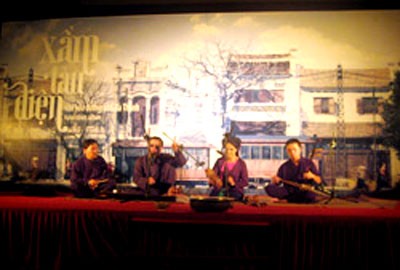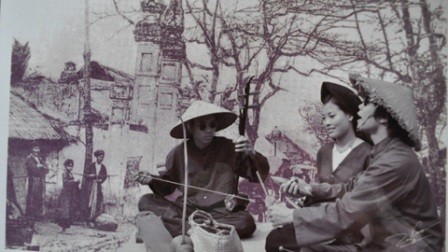(VOVworld)- Xam singing known as streetcar singing appeared in the north of Vietnam long ago. In Hanoi, there’s a unique style of Xam singing, called Xam tau dien, which was performed on trams or streetcars by mostly itinerant blind artists accompanied by dan nhi (two-string violin) or dan bau (monochord), used to charm commuters daily. After 20 years falling into oblivion, the strains of Xam tau dien were heard again in the capital city over the weekends, with a series of concerts at the Women's Museum.

The so called “Xam tau dien” or streetcar singing used to be closely associated to the lives of Hanoiains during the 1990s. The central streetcar station was by the Hoan Kiem lake and connected to other areas around the city including Yen Phu, Buoi market, Mo market, Cau Giay, Ha Dong and Vong. The streetcar trips became ideal stages for streetcar songs, which were mostly performed by disabled artists accompanied by a two-string violin or a monochord. People’s Artist Xuan Hoach, who has a great passion for Xam singing says: “Though the sound of the streetcar and the passengers were noisy, the sound of Xam singing was heard throughout the streetcar. All the melodies in Xam were performed in those trips. The melodies were very close to people and easy to learn”.
 |
Audiences at the recent concert “Xam tau dien- culture of Hanoi” at the Vietnam Women Museum, were inspired with the familiar melodies that used to resound on streetcar trips. Male artists were dressed in brown clothes, caps, and black glasses while female artists dressed in dark clothes with bright brassiers. The rhythm of streetcar singing was faster than other types of Xam singing. The melodies of Xam were borrowed from other styles of Vietnamese folk music such as Quan ho or love duets. Through the songs, Xam artists told stories of their tragic lives or the misery of the poor and evoked sympathy from audience. However, different from songs performed at markets, the streetcar songs were often had more elegant lyrics tailored to the tastes of city dwellers. There were always humorous songs that aimed to advertise products being sold by the performers, such as toothpicks, balm, and herbal medicines. For the shows at the Women’s Museum, the stage is decorated with a 3D photo of old Ha Noi with an image of a streetcar. Emeritus artist Thanh Ngoan, Deputy Director of Vietnam Cheo Opera Theater says: “ Xam singing is closely associated with the life of Hanoiains. We hope that in addition to those who have great passion for Xam singing, younger artists will be interested in this art form. We plan to open a stage for Xam singing and make it popular to the audience”.
For nearly a century, streetcar singing left a great impression on Hanoiains, who still freshly remember the bell of the streetcars. The performance at the Vietnam Women’s Museum has helped relive an image of Hanoi in the past and promote Hanoiains’ pride of their ancient city. Hoang Anh Tu from the Thang Long Theater says: “Through this show, we hope to popularize the streetcar singing thus introducing a beauty of old Hanoi. The songs were in praise of people and their lives during that period”.
Now, Hanoi has no more streetcars, but the value of streetcar singing remains. This art form will be restored and preserved as a cultural characteristic of Hanoi people’s lifestyles.
Bui Hang